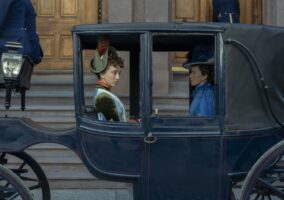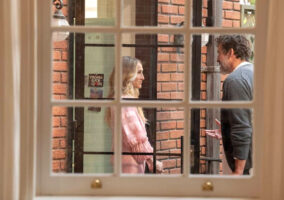In an episode entitled “The Flood,” with a closing song of “Love is Blue,” maybe it’s not such a surprise that blue featured prominently throughout the episode. And this gives us an opportunity to float our new “blue and green motif” explanation. We’ll see how long this one holds, but for some time now, we’ve been thinking the heavy uses of blue and green this season are evoking water imagery, from Don’s suicidal Hawaii ad (which set the tone for the season) up to this episode’s likening of tragedy to the Biblical flood. We reserve the right to change our minds next week when blue and green are used to signal sex or death or something like that.

It’s nice to see a return to Peggy’s power color of golden yellow, which was a recurring motif throughout her career and tended to signal either hard work or career advancement of some sort (again and again and again and again and again, all the way back to her very first scene in the series). This scene is a culmination of all that hard work, all the bullshit she put up with, and all the mousy little sweater sets and good-girl dresses in yellow she wore through it all. A nice little costuming callback to anyone paying close attention.
The realtor is sporting that very typical late ’60s NYC look of a heavy fur, goofy hat, and low-heeled shoes. It’s such an awful silhouette because it makes every woman look like a bear with stick legs, but it was popular for a time among moneyed New York women. We can’t look at it without thinking of Ruth Gordon.
Abe is The Man in Black here. He’s ominous and incongruous in the light-filled scene. We could say his black serves to illustrate his mood or we could say it’s foreshadowing for the death to come.

We remember saying last season that fans of the show’s mid-Century look were going to have a mighty tough time of it as the show progresses through the sixties. Because while it’s true that color and experimentation exploded all over design by this point, it’s also true that it brought a lot of items that look utterly hideous to 21st Century eyes. But hey, maybe some of y’all think Megan’s dress is pretty somehow. The metallic part is vintage and Janie Bryant added the pink sleeves, which were a perfectly of-its-time way to reinterpret the dress. Metallics signal wealth in the female characters on this show and the dress also serves a secondary function of hearkening to all the Eastern styles permeating design at the time. Of course, this is more “Eastern” by way of “I Dream of Jeannie,” but still. It’s a loud, attention-seeking, uber-trendy dress; an actress’s dress.
Sylvia’s not only sporting the black-and-white combo that defines her, she’s also wearing the whore-red that defines how Don sees her. But of course, the real story with her outfit is how much it stands in opposition to Megan’s modstravaganza. She is every inch the dutiful Doctor’s wife. It’s just that she’s subtly cast in red and animal print, which give her matronly outfit a more sexual feel.

We’re not kidding when we say we both gasped and blurted out “PRADA!” at the sight of Peggy’s gown. That really could be walking an Italian runway right now. That doesn’t mean it was trendy in 1968, though. Acceptable and pretty, with a more youthful vibe than, say Ted’s wife’s outfit:

But certainly not trendy on Megan’s level. More like something a Johnson daughter would wear at a White House reception. Megan and Peggy are wearing outfits that are having a conversation with each other; one that mimics the conversation they’re actually having. “We’re alike in some ways but very different in others.” With the heavy use of pinks and Peggy’s more traditional flowers going up against Megan’s swirling metallics, it’s like two definitions of female success, laid out in dress form. Two women whose success is tied to the same man but who took extremely different routes.

It’s a shame we don’t see more of this spectacular dress (although it’s all over the season 6 promotional materials), but it sets off a motif (or a deluge, if you will) of women in dark blue.

There’s little to note here except that she’s essentially a Jewish Peggy Olsen, swapping out the Peter Pan collar for the trendier big, pointy one. Ginsberg is a sartorial mess, which is really the only costuming choice for him that makes any sense. She is the focal point of the scene, standing out against all that yellow and red. He practically fades away next to her.

A plaid, a paisley, an ikat and a stripe. Using costumes to depict turmoil, but doing it in a way that you’d never notice, looking at it passively.

We detected a slight uptick in the quality of Betty’s outfits this week. She doesn’t quite give off that feel of having given up anymore. This is stylish in a “respectable wife and mother” kind of way. Paisleys aren’t really Betty’s thing, although she wore a more subtle one back in the Ossining days, at Sally’s birthday party. But they’re very much on the fashion scene now, thanks to the hippies, and this swirling cacophony of colors is yet another example of counterculture styles winding up in highly establishment and traditional places, like a well-to-do Republican housewife in Rye, New York.
There’s so much competing pattern in this scene it’s a bit unsettling.

Trudy is almost always depicted in this setting wearing wild prints that compete with it. She also tends toward autumnal colors that can be found throughout her home. But here, she is in a very definitive solid midnight blue. This calls to mind what she wore on the couch the weekend after JFK’s assassination, but it also helps visually affirm her resolve and the fact that her role in this house has changed dramatically.

We’re almost uncomfortable playing “Let’s compare the only two black characters in the cast,” but since they’re each Don and Peggy’s secretaries respectively, and since they were in identically staged scenes, we think it’s fair to say Phyllis and Dawn are meant to be compared. Phyllis is clearly trendier (dig those pointy collars) and much more likely to call attention to herself in the office. There was some slight indication that Phyllis doesn’t live in the city the way Dawn does and we’re surmising that she’s more middle class in background than Dawn, simply by virtue of the fact that she dresses better and seems less concerned with how all the white people around her think of her.
Peggy’s clothes are meant to fade into the background in this scene, leaving all the visual weight to Phyllis. But jeez, just how many coats does Miss Olson have? This is like the 4th or 5th one we’ve seen this season. Girl clearly likes to spend her money on outerwear. Of course, all her coats are essentially men’s coats interpreted for women. Business coats.

We thought Teyonah Parris really knocked it out of the park this scene and her blank-faced responses to all these nutty people around her reminded us so much of early-season Peggy Olson. Like Phyllis, she’s all done up in checks of blue and brown. Unlike Phyllis, she’s here to keep her head down and work, so her clothes are, well, a lot more workmanlike and a lot less stylish.
When Peggy hugs Phyllis, she’s in a washed-out blue that causes her to recede in the scene, letting Phyllis’ emotional response dictate things. When Joan quite awkwardly hugs Dawn, she’s so loud and attention-seeking in the scene that she can’t even see the other woman’s emotions. In other words, Peggy was dressed quietly and gave a hug to a crying woman seeking a hug. Joan was dressed loudly and gave a hug to a composed woman who really didn’t want to be hugged.
Having said that, Joan’s outfit’s is pretty fab. That circle brooch of hers is getting quite a workout this season.

Yes, she’s wearing a blue-and-green combo, but we think it’s more notable that she matches her kitchen exactly. Again. When things aren’t so great in the Francis home, you’ll see a bunch of competing patterns and prints on the family, like the scene above or the one when Betty came home with her new hair. But when Betty is, for lack of better phrasing, doing her job well (as she is in this scene), she tends to be more serenely tied to the home.

Just look at that final shot. These men are all costumed so distinctly that you almost don’t need words for the scene. But Janie’s working on an ironic level, because the man dressed the least traditionally is the one making racist comments while the purely establishment Pete is the one expressing outrage and shame. Bert stands as the old, old guard – apart from them, having virtually nothing to do with them from a visual sense. He is utterly pointless in this conversation of warring sides among the young.
Bert rarely – if ever – wears black. It would seem a bit much from a story perspective to argue that the Randian Bert Cooper was in mourning for Martin Luther King, but it does provide a nice extra-story visual reminder of grief and darkness.
Harry’s pants are hilarious. We’d sell our plasma for a matching set of those green chairs outside their offices.

Wearing green while talking about money and feeling just a little dirty about it.

Another example of ironic costuming. The two counter-culture guys in the room are not the ones most strung out (although Stan’s really giving it his all). Instead, it’s the most conservatively dressed man in the room who’s tripping his balls off. This, and the Harry costuming, are more ways for Janie to illustrate how the walls between culture and counterculture have broken down already, six months after the Summer of Love. Madison Avenue has already co-opted the counterculture, and all the ways in which it was signaled, from drug use to free love to more wild dressing, is already being watered down for the masses and stripped of its power.

Don is in a plaid, Sally’s in a plaid. Don is in blue, Bobby and Gene are in blue. You can see who’s related to whom just by looking at the costumes. Megan is the only female character to not wear blue in this episode. We’re not sure if that means anything, but her status as the only person in this scene not blood-related to anyone else is definitely affirmed in the costuming and foreshadows her confrontation with Don at the end of the episode.
Is it wrong that we kind of want Gene’s hoodie?

She’s wearing the pants, people. For the first time ever. 1968 is pretty much the exact moment when the stigma against women wearing pants declined in power. It would still be a “thing” for another decade or so among the more chauvinistic, traditionally minded set to sneer at women in pants, but for the most part, this is when the shift occurred, and the following few years would see the skirt-only dress code fade away in schools and offices.
It’s not a coincidence that she’s dressed in pants for a story about how she’s buying her own home and struggling to keep her boyfriend involved. Peggy’s a trailblazer but she’ll always be a good Catholic girl from an outer borough, so it’s perfectly within character for her to have waited so long to sport them.

Another lady in blue.
And a reversal of this scene:

Megan’s pulling from the opposite side of the color wheel, sporting a declarative orange that ties her in to the bedroom. She’s more confrontational in this outfit than Betty is in hers. This also continues a motif with Don and Megan where one of them is dressed and the other is in pajamas, as in the living room scene above, with the kids – and about 2 dozen other scenes, going back to their spankfest hatesex on the living room floor at the beginning of last season, which pretty much defined their relationship as one of competing power.

And finally, much like Joan wearing the fur Roger gave her the night she dabbled in prostitution, Janie Bryant is using a former costume of Betty’s to show us how different her life is from the last time we saw her wear it:

That would be the night her previous marriage pretty much came to an end with the revelation of Don’s affair with Bobbi Barrett. How telling that the dress she holds up in the mirror to berate herself for being imperfect is the last dress she put on with the comfortable delusion of thinking her marriage to Don was solid.
At some point, we all need to have a discussion as to why Betty’s still in the story. If Mad Men was a novel, we’d swear it was being written toward an ending where Don and Betty reunite (in California, no less), although we have an almost-impossible time seeing the series end that way. Still, scenes like this one have us questioning.
EDITED TO ADD: There’s been some debate as to whether those two Betty dresses are the same dress. We could point out all the corresponding details it took us an hour of zooming in to spot and note, but we’ll skip all that and just let you know that we sent a message to Janie Bryant asking about it and she confirmed it. She was thrilled that someone noticed(, they said, checking their fingernails and trying to sound nonchalant).
[Stills: tomandlorenzo.com]
Mad Men: The Flood Next Post:
Mad T LOunge
Please review our Community Guidelines before posting a comment. Thank you!



